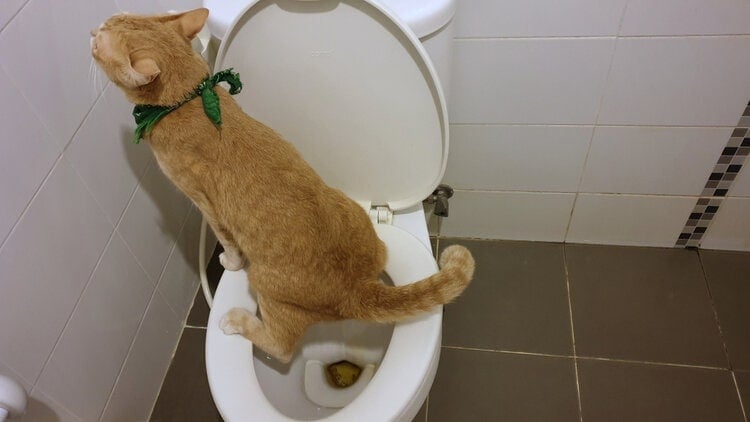Why You Must Never Flush Cat Poop Down Your Toilet - Important Information
Why You Must Never Flush Cat Poop Down Your Toilet - Important Information
Blog Article
The content following next about How to Dispose of Cat Poop and Litter Without Plastic Bags is really fascinating. Have a go and draw your own personal ideas.

Introduction
As cat owners, it's important to bear in mind how we throw away our feline pals' waste. While it may appear practical to flush cat poop down the bathroom, this practice can have harmful consequences for both the atmosphere and human wellness.
Alternatives to Flushing
The good news is, there are safer and more liable means to deal with cat poop. Take into consideration the following alternatives:
1. Scoop and Dispose in Trash
One of the most common technique of disposing of pet cat poop is to scoop it right into a naturally degradable bag and toss it in the trash. Make sure to utilize a devoted trash scoop and deal with the waste immediately.
2. Usage Biodegradable Litter
Choose eco-friendly feline clutter made from products such as corn or wheat. These clutters are environmentally friendly and can be safely taken care of in the trash.
3. Bury in the Yard
If you have a lawn, consider burying pet cat waste in an assigned location far from veggie gardens and water resources. Be sure to dig deep adequate to avoid contamination of groundwater.
4. Mount a Pet Waste Disposal System
Invest in a pet waste disposal system particularly created for feline waste. These systems utilize enzymes to break down the waste, reducing smell and ecological impact.
Wellness Risks
In addition to ecological concerns, flushing cat waste can likewise present wellness risks to human beings. Feline feces may consist of Toxoplasma gondii, a bloodsucker that can trigger toxoplasmosis-- a possibly serious illness, specifically for expectant ladies and individuals with weakened immune systems.
Environmental Impact
Purging pet cat poop presents damaging pathogens and parasites right into the water system, positioning a significant threat to water environments. These pollutants can adversely influence marine life and compromise water quality.
Conclusion
Accountable pet possession extends past supplying food and sanctuary-- it likewise entails correct waste administration. By avoiding purging pet cat poop down the toilet and opting for different disposal techniques, we can reduce our ecological impact and safeguard human health.
Why Can’t I Flush Cat Poop?
It Spreads a Parasite
Cats are frequently infected with a parasite called toxoplasma gondii. The parasite causes an infection called toxoplasmosis. It is usually harmless to cats. The parasite only uses cat poop as a host for its eggs. Otherwise, the cat’s immune system usually keeps the infection at low enough levels to maintain its own health. But it does not stop the develop of eggs. These eggs are tiny and surprisingly tough. They may survive for a year before they begin to grow. But that’s the problem.
Our wastewater system is not designed to deal with toxoplasmosis eggs. Instead, most eggs will flush from your toilet into sewers and wastewater management plants. After the sewage is treated for many other harmful things in it, it is typically released into local rivers, lakes, or oceans. Here, the toxoplasmosis eggs can find new hosts, including starfish, crabs, otters, and many other wildlife. For many, this is a significant risk to their health. Toxoplasmosis can also end up infecting water sources that are important for agriculture, which means our deer, pigs, and sheep can get infected too.
Is There Risk to Humans?
There can be a risk to human life from flushing cat poop down the toilet. If you do so, the parasites from your cat’s poop can end up in shellfish, game animals, or livestock. If this meat is then served raw or undercooked, the people who eat it can get sick.
In fact, according to the CDC, 40 million people in the United States are infected with toxoplasma gondii. They get it from exposure to infected seafood, or from some kind of cat poop contamination, like drinking from a stream that is contaminated or touching anything that has come into contact with cat poop. That includes just cleaning a cat litter box.
Most people who get infected with these parasites will not develop any symptoms. However, for pregnant women or for those with compromised immune systems, the parasite can cause severe health problems.
How to Handle Cat Poop
The best way to handle cat poop is actually to clean the box more often. The eggs that the parasite sheds will not become active until one to five days after the cat poops. That means that if you clean daily, you’re much less likely to come into direct contact with infectious eggs.
That said, always dispose of cat poop in the garbage and not down the toilet. Wash your hands before and after you clean the litter box, and bring the bag of poop right outside to your garbage bins.
https://trenchlesssolutionsusa.com/why-cant-i-flush-cat-poop/

As a keen person who reads about How to Dispose of Cat Poop and Litter Without Plastic Bags, I figured sharing that article post was beneficial. Sharing is nice. Helping people is fun. We appreciate reading our article about Can You Flush Cat Poo or Litter Down the Toilet?.
Book With Us Today! Report this page